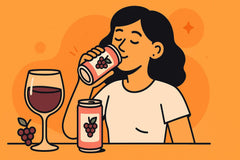Since wine packaging doesn’t include nutritional information, it’s easy to forget that wine does have calories. But how many calories are in a glass of wine? Here we breakdown some tips and tricks to picking out a wine that suits your personal preference AND works with your health goals.
Let’s start with the basics …
There are two major factors when identifying how calorically dense a glass of wine will be:
- Amount of alcohol
- Sugar content
Both alcohol and sugar are high in calories per gram, but the hard stuff almost always trumps a sweeter glass. That’s because a gram of alcohol has 7 calories, while a gram of sugar has 4 calories. This means that a wine with a higher ABV (13.5% and above) will likely have the most calories, while a low ABV wine that’s high in sugar won’t necessarily be “low calorie”, but it will be less than the more alcoholic glass.
So what if you’re at a wedding and don’t have access to the label? Or you go to the office holiday party and there’s two boxed wines — a white and a red? The following is some general guidance to help determine which wine to choose, so you can have your evening glass of wine and honor your calorie restrictions.
WHITE WINES VS. RED WINES
In general, red wine has more calories than white wine because red wine often has a higher alcohol content. If you don’t have access to the wine labels, but the dinner party host asks if you prefer white or red, white wine is likely the better option in an attempt to cut back.
This is also why a white wine is a great beverage to serve the adults at Thanksgiving! It doesn’t weigh down the meal as much as a full-bodied red, so everyone can save room for pie.
DRY WINES VS. “SWEET” WINES
There’s no denying that a sweet wine will generally be heavier than a dry wine, and this is particularly true within each “genre” (red, white, rosé, sparkling, etc.). A dry Sauvignon Blanc has about 122 calories in a serving, while a sweeter (yet less alcoholic) Moscato can have 5 more.
Of course, this is only a 5-calorie difference. What’s the big deal? And you’re right (it’s not) — for normal “everyday” wines, there isn’t that big of a difference in each glass. Even in an extreme example comparing a dry and high ABV Bordeaux Red to a sweet and low ABV Moscato d’Asti, the red wine was only 18 calories higher than the red wine.
But that’s an everyday wine. It’s when we look at the full spectrum of wines that we see why it might be a good idea to stay away from the sweet stuff … or at least turn down that second glass of Ruby Port during the holiday season. Dessert wines have the highest number of calories (up to 300 calories per 5 oz. pour) and can rack up the calories fast.
SPARKLING WINES VS. STILL WINES
Sparkling wines lean higher in sugar content and (you guessed it) higher in calories. Sugar is added in the sparkling wine-making process, including wines in the Champagne region. But if bubbly is your preference, there’s still a way to control the amount of calories you consume.
Per official regulations, Champagne can’t exceed 12.5% alcohol, but it ranges grealty in sweetness from bone dry (Brut Nature/Zero) to very sweet (Doux). Choose a dry wine like Brut Nature or Extra Brut for the least amount of calories. For moderate calories but some sweetness, go with Brut, Extra Dry or Dry.
If calories are your main concern, avoid popping a Demi-Sec or Doux. These have the most calories per serving, and will taste very sweet compared to the previous five levels of dryness.
CANNED WINES VS. BOTTLED WINES
Of course, what’s inside the bottle is only part of what determines how many calories are consumed. Like food, the other part is portion control.
Just because you choose a dry Riesling, doesn’t mean you’re doing yourself any favors by pouring a second glass and a third … but we don’t blame you! A glass bottle makes it tempting to pour glass after glass (don’t even get us started on the boxed varieties). Three glasses of a dry and low ABV Riesling add up. The calories in this large serving can quickly surpass a single glass of a California Cabernet Sauvignon.
This is why canned wine is the best packaging when trying to control the amount of calories consumed. For example, one can of Graham + Fisk’s Wine-In-A-Can is a single serving and equals ⅓ of a regular (750 ml) glass bottle.
Opening up a single can means your perfect portion is already there. So whether you’re trying to keep weight off during the holiday season or you’re making goals for the New Year, wine can still be a part of your plan. Cheers to that!







